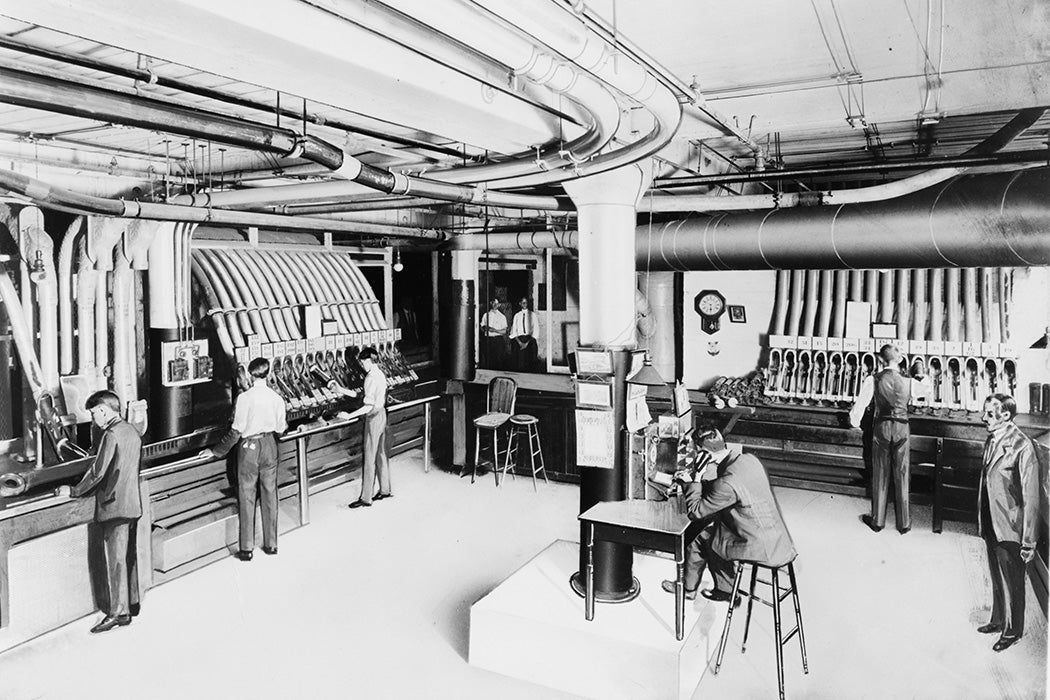Under many cities, buried among the sewer and gas lines, are the remnants of a pneumatic tube system, installed to distribute mail in the 1860s. The system relied on sheet-steel cylindrical containers and compressed air. Letters were secured in the containers and dropped into a network of tubes; compressed air propelled the container to its destination. Hopes for this cutting-edge technology were high in the late nineteenth century. Pneumatic transportation once seemed to be on its way to reality, with pneumatic subways trialed in New York. At one point there was even a plan to create a pneumatic freight line between New York and New Orleans.
In 1897, Scientific American described the opening of the new pneumatic postal system in New York. Promoted as something that would “effect a revolution in the business methods of the retail tradesmen, placing them in hourly contact with the wholesale houses,” the system was held to be faster than sending a telegram (by more than fifty minutes), and the aspiration was that, with an expansion of the network, people would be able to send a letter from New York to Philadelphia and receive a reply the same day. Within New York, the system would be able to carry 250,000 letters per hour, in each direction.
If the pneumatic tube network was still operable, the speed of postal delivery within a city served by it would still be unbeatable today (even with the keenest bicycle courier). Our postal services don’t offer such speed or the multiple daily deliveries that many cities once boasted.
Retailers installed the systems to send cash in tubes from sales counters up to the accounting office; offices used them to send memos. As Scientific American noted in 1880, the tubes improved the efficiency, “not only sav[ing] time and noise, but the wages of an army of boys or girls, besides discharging a large amount of fresh air into the building, greatly improving ventilation.”
In that particular setting, a customer’s payment would be sent up to a central accounting office and change sent back down. In practice, most stores didn’t use the pneumatic tubes for every single sale, instead requiring cashiers to send up cash from the register in capsules at fixed periods to avoid having large amounts of money sitting in the register drawer.
Weekly Newsletter
Hotels also used pneumatic tubes to send messages, and in 1899, New York’s Waldorf-Astoria Hotel had a system that handled ten thousand notes, letters, and newspapers for its 1,200 guests every day. Pneumatic postal systems dropped out of favor by the mid-twentieth century; instant communication was overtaken by the telephone, which itself has been overtaken by email and text messaging. Pneumatic systems do linger in some corners of retail (less needed today as more transactions are cashless), and there are some pneumatic trash disposal systems around the world (including on New York’s Roosevelt Island). And you can still find them at some local banks today; a pneumatic tube is used to pass a deposit slip and check to the teller staffing the drive-up window. But since the advent of ATMs, the number in use has dwindled.
That doesn’t mean we can’t imagine the world pneumatic delivery could have made, and perhaps we can dream of a pneumatic system once again. Imagine ordering a pizza from a restaurant across town and having it shoot through underground pipes to get to you in minutes. Or having your prescription sent from the pharmacy in seconds. Amazon could offer pneumatic Prime delivery. Maybe what is old will once again be pneu.
Support JSTOR Daily! Join our membership program on Patreon today.







